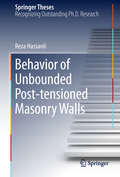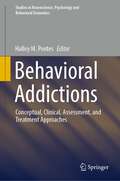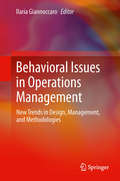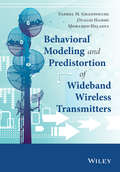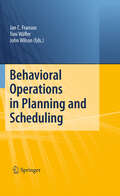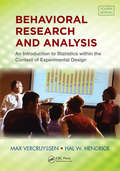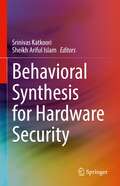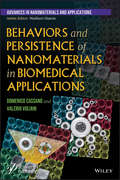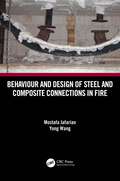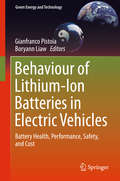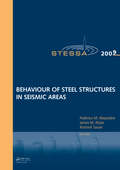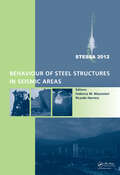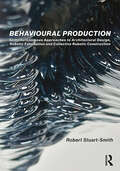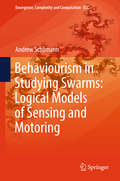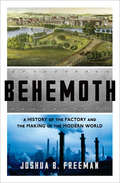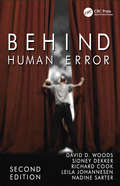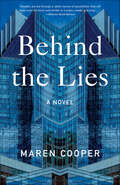- Table View
- List View
Behavior of Radionuclides in the Environment III: Fukushima
by Alexei Konoplev Kenji Nanba Toshihiro WadaThis book, the third in the series Behavior of Radionuclides in the Environment, is dedicated to Fukushima. Major findings from research since 2011 are reviewed concerning the behavior of radionuclides released into the environment due to the Fukushima Dai-ichi Nuclear Power Plant accident, including atmospheric transport and fallout of radionuclides, their fate, and transport in the soil-water environment, behavior in freshwater, coastal and marine environment, transfer in the terrestrial and agricultural environment. Volume III discusses not only radionuclides dynamics in the environment in the short- and mid-term, but also modeling and prediction of long-term time changes.Along with reviews, the book contains original data and results not published previously. It was spearheaded by the authors from the Institute of Environmental Radioactivity at Fukushima University, established two years after the Fukushima accident, with their collaborators from Japan, Russia, and Ukraine. The knowledge emerging from the studies of the environmental behavior of Fukushima-derived radionuclides enables us to move forward in understanding mechanisms of environmental contamination and leads to better modeling and prediction of long-term pollution effects in general.
Behavior of Unbounded Post- tensioned Masonry Walls (Springer Theses)
by Reza HassanliThis book reports on a comprehensive analytical, experimental and numerical study on the flexural response of post-tensioned masonry walls under in-plane loads. It explores an important mechanism in this new generation of structural walls, called “Self-centering”. This mechanism can reduce residual drifts and structural damage during earthquake ground motion, and is particularly favorable for structures which are designed for immediate occupancy performance levels. The book reports on the development and verification of a finite element model of post-tensioned masonry walls. It describes a detailed parametric study to predict the strength of post-tensioned masonry walls. New design methodologies and expressions are developed to predict the flexural strength and force-displacement response of post-tensioned masonry. Experimental study is carried out to better understand the behavior of post-tensioned masonry walls and also to evaluate the accuracy of the proposed design procedure and expressions. The book also includes an introduction to current research on unbounded post-tensioned masonry walls, together with an extensive analysis of previously published test results.
Behavioral Addictions: Conceptual, Clinical, Assessment, and Treatment Approaches (Studies in Neuroscience, Psychology and Behavioral Economics)
by Halley M. PontesThis book provides a holistic evidence-based perspective on conceptual, clinical, assessment, and treatment aspects of key non-substance-based addictive disorders related to: gambling, gaming, social media, smartphone, internet, love, sex, exercise, work, and shopping. Each chapter focuses on a different addictive disorder and is structured in a user-friendly way to enable the reader fast navigation, yet the main aspects of the respective disorders are covered in the necessary depth. All in all, this book offers a timely, self-contained introduction to both key concepts and the latest scientific developments in behavioral addictions. It addresses mental health practitioners, researchers in psychology, neuroscience and communication, and undergraduate and postgraduate students alike.
Behavioral Cybersecurity: Applications of Personality Psychology and Computer Science
by Wayne Patterson Cynthia E. Winston-ProctorSince the introduction and proliferation of the Internet, problems involved with maintaining cybersecurity has grown exponentially, and have evolved into many forms of exploitation. Yet, Cybersecurity has had far too little study and research. Virtually all of the Research that has taken place in cybersecurity over many years, has been done by those with computer science, electrical engineering, and mathematics backgrounds. However, many cybersecurity researchers have come to realize that to gain a full understanding of how to protect a cyber environment requires not only the knowledge of those researchers in computer science, engineering and mathematics, but those who have a deeper understanding of human behavior: researchers with expertise in the various branches of behavioral science, such as psychology, behavioral economics, and other aspects of brain science. The authors, one a computer scientist and the other a psychologist, have attempted over the past several years to understand the contributions that each approach to cybersecurity problems can benefit from this integrated approach that we have tended to call "behavioral cybersecurity." The authors believe that the research and curriculum approaches developed from this integrated approach provide a first book with this approach to cybersecurity. This book incorporates traditional technical computational and analytic approaches to cybersecurity, and also psychological and human factors approaches, as well. Features Discusses profiling approaches and risk management Includes case studies of major cybersecurity events and "Fake News" Presents analyses of password attacks and defenses Addresses game theory, behavioral economics and their application to cybersecurity Supplies research into attacker/defender personality and motivation traits Techniques for measuring cyber attacks/defenses using crypto and stego
Behavioral Health and Human Interactions in Space
by Nick KanasThis textbook covers the range of psychological and interpersonal issues that can affect astronauts living and working in space. It deals with the three major risk areas cited by NASA’s Behavioral Health and Performance Element: Behavioral Medicine, Team Risk, and Sleep Risk. Based on the author’s more than 50 years of experience in space-related activities writing, conducting research, and teaching undergraduate and graduate courses, the book follows a comprehensive range of topics that include: cognitive effects; psychiatric issues; cultural influences; salutogenic and positive aspects of space travel; autonomy and delayed communication; current plans to return to the Moon and Mars; analysis of study environments such as the polar regions, submersible habitats, and space simulation facilities; and more. It draws on research, literature, and case studies from the 1950s onward, showing readers in a natural and accessible way how the field has progressed over time. The book contains ample end-of-chapter summaries and exercises as well as a complete glossary of key terms. As such, it will serve students taking courses in aerospace psychology, psychiatry, sociology, human factors, medicine, and related social sciences, in addition to space industry professionals and others interested in the complexities of people living and working in space.
Behavioral Issues in Operations Management: New Trends in Design, Management, and Methodologies
by Ilaria GiannoccaroBehavioral Operations Management has been identified in the last years as one of the most promising emerging fields in Operations Management. Behavioral Issues in Operations Management explains and examines up-to-date research in this field, which works to analyze the impact of human behavior on the management of complex operating systems. A collection of studies from leading scholars presents different methodologies and approaches, supported by real data and case studies. Issues such as building trust and strong cooperative relationships with suppliers, enhancing motivation and designing proper incentives for stimulating more effective decision maker behaviours are considered. The main decision-making processes affected by behavioral issues are also analyzed with a focus on new product development, logistics, and supply chain integration. The broad coverage of methodologies and practical implications makes Behavioral Issues in Operations Management an ideal reference for both researchers developing new topics such as NK fitness landscapes and managers with an interest in behavioral management operations.
Behavioral Modeling and Predistortion of Wideband Wireless Transmitters
by Fadhel M. Ghannouchi Oualid Hammi Mohamed HelaouiCovers theoretical and practical aspects related to the behavioral modelling and predistortion of wireless transmitters and power amplifiers. It includes simulation software that enables the users to apply the theory presented in the book. In the first section, the reader is given the general background of nonlinear dynamic systems along with their behavioral modelling from all its aspects. In the second part, a comprehensive compilation of behavioral models formulations and structures is provided including memory polynomial based models, box oriented models such as Hammerstein-based and Wiener-based models, and neural networks-based models. The book will be a valuable resource for design engineers, industrial engineers, applications engineers, postgraduate students, and researchers working on power amplifiers modelling, linearization, and design.
Behavioral Operations in Planning and Scheduling
by Jan C. Fransoo John R. Wilson Toni WaeflerHuman and organizational factors have a substantial impact on the performance of planning and scheduling processes. Despite widespread and advanced decision support systems, human decision makers are still crucial to improve the operational performance in manufacturing industries. In this text, the state of the art in this area is discussed by experts from a wide variety of engineering and social science disciplines. Moreover, recent results from collaborative studies and a number of field cases are presented. The text is targeted at researchers and graduate students, but is also particularly useful for managers, consultants, and system developers to better understand how human performance can be advanced.
Behavioral Predictive Modeling in Economics (Studies in Computational Intelligence #897)
by Vladik Kreinovich Songsak Sriboonchitta Woraphon YamakaThis book presents both methodological papers on and examples of applying behavioral predictive models to specific economic problems, with a focus on how to take into account people's behavior when making economic predictions. This is an important issue, since traditional economic models assumed that people make wise economic decisions based on a detailed rational analysis of all the relevant aspects. However, in reality – as Nobel Prize-winning research has shown – people have a limited ability to process information and, as a result, their decisions are not always optimal. Discussing the need for prediction-oriented statistical techniques, since many statistical methods currently used in economics focus more on model fitting and do not always lead to good predictions, the book is a valuable resource for researchers and students interested in the latest results and challenges and for practitioners wanting to learn how to use state-of-the-art techniques.
Behavioral Research and Analysis: An Introduction to Statistics within the Context of Experimental Design, Fourth Edition
by Max Vercruyssen Hal W. HendrickNow in its fourth edition, Behavioral Research and Analysis: An Introduction to Statistics within the Context of Experimental Design presents an overview of statistical methods within the context of experimental design. It covers fundamental topics such as data collection, data analysis, interpretation of results, and communication of findings
Behavioral Synthesis for Hardware Security
by Srinivas Katkoori Sheikh Ariful IslamThis book presents state-of-the-art research results from leading electronic design automation (EDA) researchers on automated approaches for generating cyber-secure, smart hardware. The authors first provide brief background on high-level synthesis principles and motivate the need for secure design during behavioral synthesis. Then they provide readers with synthesis techniques for six automated security solutions, namely, hardware obfuscation, hardware Trojan detection, IP watermarking, state encoding, side channel attack resistance, and information flow tracking.Provides a single-source reference to behavioral synthesis for hardware security;Describes automatic synthesis techniques for algorithmic obfuscation, using code transformations;Includes behavioral synthesis techniques for intellectual property protection.
Behaviors and Persistence of Nanomaterials in Biomedical Applications
by Domenico Cassano Valerio VolianiIn the last two decades, several promising engineered nanomaterials that combine therapeutic features and imaging functionalities have been presented, but very few have arrived on the market.The purpose of this book is to collect and comprehensively discuss the advances in this current and exciting topic in order to promote and enhance its growth. In the first part, a general introduction about the main features of both organic and inorganic nanomaterials is provided. Then, the most promising and innovative applications for cancer treatment and diagnostic are introduced.In the second part, an analysis of the nanomaterials in the market for healthcare applications is presented. The issue of unwanted accumulation of metals in organisms after the designed action is then discussed. Finally, the most recent progresses in the design of nanomaterials that are able to escape from organisms after the selected action are comprehensively described, and the perspectives of this exciting field provided.
Behaviour and Design of Steel Structures to AS4100 (Australian Third Edition)
by Nick Trahair Mark A BradfordThe behaviour of steel structures and the criteria used in their design are set out in detail in this book. The book bridges the gap between the methods of analysis and the sizing of structural components. The basis of the limit state design criteria of the latest Australian code for structural steel are explained, and the reader is pointed to the relevant provisions of the code.
Behaviour and Design of Steel and Composite Connections in Fire
by Yong Wang Mostafa JafarianUnder fire conditions, the strong interactions in structures result in different load carrying mechanisms and drastic redistributions of internal forces in structural members, which are concentrated at and transferred via connections. Fire safety depends on the performance of these connections, including their temperature distribution and load-carrying mechanisms, and good performance ensures structural robustness in fire. Behaviour and Design of Steel and Composite Connections in Fire is the only dedicated book on fire performance of connections in steel and composite structures. Recent experimental and numerical studies, from individual elements to whole, real-scale structures, have indicated that connections are among the most vulnerable and critical parts of these structures. This book synthesises the research findings on this important subject and explains the essential features in an accessible way in one single source. The book is ideal for researchers, structural engineers and fire protection engineers in their applications of performance-based fire engineering.
Behaviour of Lithium-Ion Batteries in Electric Vehicles
by Gianfranco Pistoia Boryann LiawThis book surveys state-of-the-art research on and developments in lithium-ion batteries for hybrid and electric vehicles. It summarizes their features in terms of performance, cost, service life, management, charging facilities, and safety. Vehicle electrification is now commonly accepted as a means of reducing fossil-fuels consumption and air pollution. At present, every electric vehicle on the road is powered by a lithium-ion battery.Currently, batteries based on lithium-ion technology are ranked first in terms of performance, reliability and safety. Though other systems, e.g., metal-air, lithium-sulphur, solid state, and aluminium-ion, are now being investigated, the lithium-ion system is likely to dominate for at least the next decade – which is why several manufacturers, e.g., Toyota, Nissan and Tesla, are chiefly focusing on this technology.Providing comprehensive information on lithium-ion batteries, the book includes contributions by the world’s leading experts on Li-ion batteries and vehicles.
Behaviour of Steel Structures in Seismic Areas: STESSA 2009
by Federico M. Mazzolani James M. Ricles Richard SauseBehaviour of Steel Structures in Seismic Areas comprises the latest progress in both theoretical and experimental research on the behaviour of steel structures in seismic areas. The book presents the most recent trends in the field of steel structures in seismic areas, with particular reference to the utilisation of multi-level performance bas
Behaviour of Steel Structures in Seismic Areas: STESSA 2012
by Federico Mazzolani Ricardo HerreraBehaviour of Steel Structures in Seismic Areas is a comprehensive overview of recent developments in the field of seismic resistant steel structures. It comprises a collection of papers presented at the seventh International Specialty Conference STESSA 2012 (Santiago, Chile, 9-11 January 2012), and includes the state-of-the-art in both theore
Behavioural Adaptation and Road Safety: Theory, Evidence and Action
by Christina M. Rudin-Brown Samantha L. JamsonDespite being an accepted construct in traffic and transport psychology, the precise nature of behavioural adaptation, including its causes and consequences, has not yet been established within the road safety community. A comprehensive collection of recent literature, Behavioural Adaptation and Road Safety: Theory, Evidence, and Action explores be
Behavioural Production: Semi-Autonomous Approaches to Architectural Design, Robotic Fabrication and Collective Robotic Construction
by Robert Stuart-SmithAutonomous manufacturing and cyber-physical systems are key enabling technologies of the Fourth Industrial Revolution (IR4) which are currently being incorporated into the building design and construction industries. These emerging IR4 technologies have the potential to effectively improve construction affordability and productivity, address current and future building demand, and reduce the environmental impact of the built environment. However, design approaches that make use of IR4 technologies are still relatively unexplored. While automation, such as mass production, promotes standardised design solutions, design thinking that embraces varying degrees of autonomy can lead to unique and considered approaches to design on an industrial scale.Behavioural Production: Semi-Autonomous Approaches to Architectural Design, Robotic Fabrication and Collective Robotic Construction explores design operating through the orchestration of spatiotemporal events. A multi-agent behaviour-based approach to computation is employed in architectural design and extended to individual and swarm-based robotic methods for additive manufacturing. Behavioural Production seeks to expand our capacity to engage with the world at large through varying degrees of autonomy. In an industrialised world where traditional craftsmanship has been marginalised and cannot scale to meet societal needs, this book speculates a means to bring scalable forms of creativity into the act of making. This is explored through the use of materials, generative algorithms, computer vision, machine learning, and robot systems as active agents in design conception and realisation. The book presents a collection of ideas, projects, and methods developed in the author’s design practices and research labs in the fields of architecture and computer science. This body of work demonstrates that engaging with semi-autonomous processes does not diminish authorship, but rather expands it into new forms of design agency that seamlessly integrate with emerging manufacturing and construction technologies whilst authoring distinctive design character.
Behavioural Science and Housing Decision Making: A Case Study Approach
by Helen BaoThis book takes a behavioural approach to examine six important housing questions: tenure decision, gentrification, place attachment, housing bubbles, housing wealth, and residential satisfaction. Using experimental and field data, the book demonstrates the effects of six behavioural biases and heuristics (i.e., anchoring and reference dependence, loss aversion, mental accounting, endowment effect, herd behaviours, and social comparison) on these housing decisions. The first part of the book introduces the questions and provides a behavioural science toolbox before the second part adopts a real-world case study approach. Real data sets and suggested answers are provided, and the cases come from the UK, USA, and China. Background information is given in each case to facilitate the understanding of the case data and question, as well as the discussions on the results. This book is ideal supplementary reading on a variety of courses such as housing studies, economics, real estate, research methods, and for students and academics who are interested in the application of behavioural science in housing decisions.
Behaviourism in Studying Swarms: Logical Models of Sensing and Motoring (Emergence, Complexity And Computation Ser. #33)
by Andrew SchumannThis book presents fundamental theoretical results for designing object-oriented programming languages for controlling swarms. It studies the logics of swarm behaviours. According to behaviourism, all behaviours can be controlled or even managed by stimuli in the environment: attractants (motivational reinforcement) and repellents (motivational punishment). At the same time, there are two main stages in reactions to stimuli: sensing (perceiving signals) and motoring (appropriate direct reactions to signals). This book examines the strict limits of behaviourism from the point of view of symbolic logic and algebraic mathematics: how far can animal behaviours be controlled by the topology of stimuli? On the one hand, we can try to design reversible logic gates in which the number of inputs is the same as the number of outputs. In this case, the behaviouristic stimuli are inputs in swarm computing and appropriate reactions at the motoring stage are its outputs. On the other hand, the problem is that even at the sensing stage each unicellular organism can be regarded as a logic gate in which the number of outputs (means of perceiving signals) greatly exceeds the number of inputs (signals).
Behemoth: A History Of The Factory And The Making Of The Modern World
by Joshua B. FreemanA sweeping, global history of the rise of the factory and its effects on society. We live in a factory-made world: modern life is built on three centuries of advances in factory production, efficiency, and technology. But giant factories have also fueled our fears about the future since their beginnings, when William Blake called them "dark Satanic mills." Many factories that operated over the last two centuries—such as Homestead, River Rouge, and Foxconn—were known for the labor exploitation and class warfare they engendered, not to mention the environmental devastation caused by factory production from the beginning of the Industrial Revolution up to today. In a major work of scholarship that is also wonderfully accessible, celebrated historian Joshua B. Freeman tells the story of the factory and examines how it has reflected both our dreams and our nightmares of industrialization and social change. He whisks readers from the textile mills in England that powered the Industrial Revolution and the factory towns of New England to the colossal steel and car plants of twentieth-century America, Eastern Europe, and the Soviet Union and on to today’s behemoths making sneakers, toys, and cellphones in China and Vietnam. The giant factory, Freeman shows, led a revolution that transformed human life and the environment. He traces arguments about factories and social progress through such critics and champions as Marx and Engels, Charles Dickens, Alexander Hamilton, Henry Ford, and Joseph Stalin. He chronicles protests against standard industry practices from unions and workers’ rights groups that led to shortened workdays, child labor laws, protection for organized labor, and much more. In Behemoth, Freeman also explores how factories became objects of great wonder that both inspired and horrified artists and writers in their time. He examines representations of factories in the work of Charles Sheeler, Margaret Bourke-White, Charlie Chaplin, Diego Rivera, and Edward Burtynsky. Behemoth tells the grand story of global industry from the Industrial Revolution to the present. It is a magisterial work on factories and the people whose labor made them run. And it offers a piercing perspective on how factories have shaped our societies and the challenges we face now.
Behind Human Error
by Richard Cook Sidney Dekker David D. Woods Leila Johannesen Nadine SarterHuman error is cited over and over as a cause of incidents and accidents. The result is a widespread perception of a 'human error problem', and solutions are thought to lie in changing the people or their role in the system. For example, we should reduce the human role with more automation, or regiment human behavior by stricter monitoring, rules or procedures. But in practice, things have proved not to be this simple. The label 'human error' is prejudicial and hides much more than it reveals about how a system functions or malfunctions. This book takes you behind the human error label. Divided into five parts, it begins by summarising the most significant research results. Part 2 explores how systems thinking has radically changed our understanding of how accidents occur. Part 3 explains the role of cognitive system factors - bringing knowledge to bear, changing mindset as situations and priorities change, and managing goal conflicts - in operating safely at the sharp end of systems. Part 4 studies how the clumsy use of computer technology can increase the potential for erroneous actions and assessments in many different fields of practice. And Part 5 tells how the hindsight bias always enters into attributions of error, so that what we label human error actually is the result of a social and psychological judgment process by stakeholders in the system in question to focus on only a facet of a set of interacting contributors. If you think you have a human error problem, recognize that the label itself is no explanation and no guide to countermeasures. The potential for constructive change, for progress on safety, lies behind the human error label.
Behind Their Screens: What Teens Are Facing (and Adults Are Missing)
by Carrie James Emily WeinsteinHow teens navigate a networked world and how adults can support them.What are teens actually doing on their smartphones? Contrary to many adults&’ assumptions, they are not simply &“addicted&” to their screens, oblivious to the afterlife of what they post, or missing out on personal connection. They are just trying to navigate a networked world. In Behind Their Screens, Emily Weinstein and Carrie James, Harvard researchers who are experts on teens and technology, explore the complexities that teens face in their digital lives, and suggest that many adult efforts to help—&“Get off your phone!&” &“Just don&’t sext!&”—fall short. Weinstein and James warn against a single-minded focus by adults on &“screen time.&” Teens worry about dependence on their devices, but disconnecting means being out of the loop socially, with absence perceived as rudeness or even a failure to be there for a struggling friend. Drawing on a multiyear project that surveyed more than 3,500 teens, the authors explain that young people need empathy, not exasperated eye-rolling. Adults should understand the complicated nature of teens&’ online life rather than issue commands, and they should normalize—let teens know that their challenges are shared by others—without minimizing or dismissing. Along the way, Weinstein and James describe different kinds of sexting and explain such phenomena as watermarking nudes, comparison quicksand, digital pacifiers, and collecting receipts. Behind Their Screens offers essential reading for any adult who cares about supporting teens in an online world.
Behind the Lies: A Novel
by Maren CooperWill Franklin—former academic geek, now recognized as a rare talent in the “fake it ’til you make it” biotech industry—is in the wings for his dream job as next CEO of a global powerhouse. Or so he thinks, until his boss, Chet, calls him into his office and angrily tells him he is going to be fired. Chet hints at impropriety, but won’t say more—and before Will can press him he falls so ill that he’s put on ventilator care.Now, instead of losing his job, Will finds himself in the position of supporting Chet’s family through the hell of a dire illness. Just as suddenly, he finds his leadership ability tested by a crippling cyberattack that threatens the entire industry and leaves him with little time to untangle the mystery of whatever it is that Chet uncovered before he got sick.Can Will clear his name before the ax falls—or his marriage collapses—due to his lapse in judgment? And does Bella, a young and beautiful rising star making waves with her own start-up company, have anything to do with this mess?

